Cisco UCS S3260 M5 Server with Cloudian HyperStore Object Storage Design Guide
Available Languages
Cisco UCS S3260 M5 Server with Cloudian HyperStore Object Storage Design Guide
Cisco UCS S3260 M5 Server with Cloudian HyperStore Object Storage Design Guide PDF
Last Updated: January 24, 2019
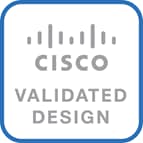
About the Cisco Validated Design Program
The Cisco Validated Design (CVD) program consists of systems and solutions designed, tested, and documented to facilitate faster, more reliable, and more predictable customer deployments. For more information, go to:
http://www.cisco.com/go/designzone.
ALL DESIGNS, SPECIFICATIONS, STATEMENTS, INFORMATION, AND RECOMMENDATIONS (COLLECTIVELY, "DESIGNS") IN THIS MANUAL ARE PRESENTED "AS IS," WITH ALL FAULTS. CISCO AND ITS SUPPLIERS DISCLAIM ALL WARRANTIES, INCLUDING, WITHOUT LIMITATION, THE WARRANTY OF MERCHANTABILITY, FITNESS FOR A PARTICULAR PURPOSE AND NONINFRINGEMENT OR ARISING FROM A COURSE OF DEALING, USAGE, OR TRADE PRACTICE. IN NO EVENT SHALL CISCO OR ITS SUPPLIERS BE LIABLE FOR ANY INDIRECT, SPECIAL, CONSEQUENTIAL, OR INCIDENTAL DAMAGES, INCLUDING, WITHOUT LIMITATION, LOST PROFITS OR LOSS OR DAMAGE TO DATA ARISING OUT OF THE USE OR INABILITY TO USE THE DESIGNS, EVEN IF CISCO OR ITS SUPPLIERS HAVE BEEN ADVISED OF THE POSSIBILITY OF SUCH DAMAGES.
THE DESIGNS ARE SUBJECT TO CHANGE WITHOUT NOTICE. USERS ARE SOLELY RESPONSIBLE FOR THEIR APPLICATION OF THE DESIGNS. THE DESIGNS DO NOT CONSTITUTE THE TECHNICAL OR OTHER PROFESSIONAL ADVICE OF CISCO, ITS SUPPLIERS OR PARTNERS. USERS SHOULD CONSULT THEIR OWN TECHNICAL ADVISORS BEFORE IMPLEMENTING THE DESIGNS. RESULTS MAY VARY DEPENDING ON FACTORS NOT TESTED BY CISCO.
CCDE, CCENT, Cisco Eos, Cisco Lumin, Cisco Nexus, Cisco StadiumVision, Cisco TelePresence, Cisco WebEx, the Cisco logo, DCE, and Welcome to the Human Network are trademarks; Changing the Way We Work, Live, Play, and Learn and Cisco Store are service marks; and Access Registrar, Aironet, AsyncOS, Bringing the Meeting To You, Catalyst, CCDA, CCDP, CCIE, CCIP, CCNA, CCNP, CCSP, CCVP, Cisco, the Cisco Certified Internetwork Expert logo, Cisco IOS, Cisco Press, Cisco Systems, Cisco Systems Capital, the Cisco Systems logo, Cisco Unified Computing System (Cisco UCS), Cisco UCS B-Series Blade Servers, Cisco UCS C-Series Rack Servers, Cisco UCS S-Series Storage Servers, Cisco UCS Manager, Cisco UCS Management Software, Cisco Unified Fabric, Cisco Application Centric Infrastructure, Cisco Nexus 9000 Series, Cisco Nexus 7000 Series. Cisco Prime Data Center Network Manager, Cisco NX-OS Software, Cisco MDS Series, Cisco Unity, Collaboration Without Limitation, EtherFast, EtherSwitch, Event Center, Fast Step, Follow Me Browsing, FormShare, GigaDrive, HomeLink, Internet Quotient, IOS, iPhone, iQuick Study, LightStream, Linksys, MediaTone, MeetingPlace, MeetingPlace Chime Sound, MGX, Networkers, Networking Academy, Network Registrar, PCNow, PIX, PowerPanels, ProConnect, ScriptShare, SenderBase, SMARTnet, Spectrum Expert, StackWise, The Fastest Way to Increase Your Internet Quotient, TransPath, WebEx, and the WebEx logo are registered trademarks of Cisco Systems, Inc. and/or its affiliates in the United States and certain other countries.
All other trademarks mentioned in this document or website are the property of their respective owners. The use of the word partner does not imply a partnership relationship between Cisco and any other company. (0809R)
© 2019 Cisco Systems, Inc. All rights reserved.
Table of Contents
Cisco Unified Computing System
Cisco UCS 6300 Fabric Interconnects
Cisco UCS S3260 M5 Storage Server
Cisco UCS C220 M5 Rack-Mount Server
Cisco UCS Virtual Interface Card 1387
Cloudian HyperStore Architecture
Integrated Billing, Management, and Monitoring
System Hardware and Software Specifications
Hardware Requirements and Bill of Materials
Physical Topology and Configuration
Physical Infrastructure Considerations
Single Node versus Dual Node Cisco UCS S3260
Replication versus Erasure Coding
Supported Erasure Coding Configurations
Cisco Validated Designs consist of systems and solutions that are designed, tested, and documented to facilitate and improve customer deployments. These designs incorporate a wide range of technologies and products into a portfolio of solutions that have been developed to address the business needs of our customers.
The purpose of this document is to describe the design of Cloudian HyperStore on Red Hat Enterprise Linux on the latest generation of Cisco UCS S3260 M5 Servers. This validated design provides the framework of designing and deploying Cloudian SDS software on Cisco UCS S3260 storage servers. The Cisco Unified Computing System provides the compute, network, and storage access components for the Cloudian HyperStore, deployed as a single cohesive system.
This design guide describes how the Cisco Unified Computing System (Cisco UCS) can be used in conjunction with Cloudian 7.1.2. With the continuous evolution of data, there has been lack of enterprise manageability for large capacity storage servers, Cisco UCS with Cloudian provide the solution to solve the challenges, as it increased demand to have Cloudian HyperStore validated on Cisco UCS servers. The Cisco UCS S3260 Storage Server, originally designed for the data center, together with Cloudian HyperStore is optimized for object storage solutions, making it an excellent fit for unstructured data workloads such as backup, archive, file celebration, storage as a service, IOT, video surveillance and cloud storage. The S3260 delivers a complete infrastructure with exceptional scalability for computing and storage resources together with 40 Gigabit Ethernet networking.
Cisco and Cloudian are collaborating to offer customers a scalable object storage solution for unstructured data that integrates UCS with Cloudian HyperStore. With the power of the Cisco UCS management framework, the solution is cost effective to deploy and manage and will enable the next-generation cloud deployments that drive business agility, lower operational costs and avoid vendor lock-in.
Introduction
Object storage is a highly scalable system for organizing and storing data objects. Object storage does not use a file system structure, instead it ingests data as objects with unique keys into a flat directory structure and the metadata is stored with the objects instead of hierarchical journal or tree. Search and retrieval is performed using RESTful API’s, which uses HTTP verbs such as GETs and PUTs. Most of the newly generated data, about 60 to 80 percent, is unstructured today and new approaches using x86 servers are proving to be more cost effective, providing storage that can be expanded as easily as your data grows. Scale-out Object storage is the newest cost effective approach for handling large amounts of data in the Petabyte and Exabyte range.
The Cloudian HyperStore is a Software-Defined Storage software that is designed to create unbounded scale-out storage systems that accommodates Petabyte scale data from multiple applications and use-cases, including both object and file based applications
Together with Cisco UCS, Cloudian Hyperstore can deliver a fully enterprise-ready solution that can manage different workloads and still remain flexible. The Cisco UCS S3260 Storage Server is an excellent platform to use with the main types of Object and File workloads, such as capacity-optimized and performance-optimized workloads. It is best suited for sequential access, as opposed to random access to unstructured data, and to whatever data size. It is essentially designed for Applications, not direct end-users.
This document describes the architecture and design procedures of Cloudian Hyperstore software on Cisco UCS S3260 M5 servers along with Cisco UCS C220 M5 Rack-Mount servers for load balancing.
Audience
The audience for this document includes, but is not limited to, sales engineers, field consultants, professional services, IT managers, partner engineers, IT architects, and customers who want to take advantage of an infrastructure that is built to deliver IT efficiency and enable IT innovation. The reader of this document is expected to have the necessary training and background to install and configure Red Hat Enterprise Linux, Cisco Unified Computing System, Cisco Nexus and Cisco UCS Manager, as well as a high-level understanding of Cloudian Hyperstore Software and its components. External references are provided where applicable and it is recommended that the reader be familiar with these documents.
Readers are also expected to be familiar with the infrastructure, network and security policies of the customer installation.
Purpose of this Document
This document describes the steps required to design Cloudian HyperStore 7.1.2 on Cisco UCS platform. It discusses design choices and best practices using this shared infrastructure platform.
Solution Summary
This solution is focused on Cloudian HyperStore Cluster on Red Hat Linux 7 on Cisco Unified Computing System. The advantages of Cisco UCS and Cloudian HyperStore combine to deliver an object storage solution that is simple to install, scalable and high performance. The configuration uses the following components for the deployment:
· Cisco Unified Computing System
- Cisco UCS 6332 Series Fabric Interconnects
- Cisco UCS S3260 M5 storage servers
- Cisco S3260 system IO controller with VIC 1380
- Cisco C220M5 servers with VIC 1387
· Cisco Nexus C9332PQ Series Switches
· Cloudian HyperStore 7.1.2
· Red Hat Enterprise Linux 7.5
Cisco Unified Computing System
Cisco Unified Computing System is a state-of-the-art data center platform that unites computing, network, storage access, and virtualization into a single cohesive system.
The main components of Cisco Unified Computing System are:
· Computing - The system is based on an entirely new class of computing system that incorporates rack-mount and blade servers based on Intel Xeon Processor scalable family. The Cisco UCS servers offer the patented Cisco Extended Memory Technology to support applications with large datasets and allow more virtual machines per server.
· Network - The system is integrated onto a low-latency, lossless, 40-Gbps unified network fabric. This network foundation consolidates LANs, SANs, and high-performance computing networks which are separate networks today. The unified fabric lowers costs by reducing the number of network adapters, switches, and cables, and by decreasing the power and cooling requirements.
· Virtualization - The system unleashes the full potential of virtualization by enhancing the scalability, performance, and operational control of virtual environments. Cisco security, policy enforcement, and diagnostic features are now extended into virtualized environments to better support changing business and IT requirements.
· Storage access - The system provides consolidated access to both SAN storage and Network Attached Storage (NAS) over the unified fabric. By unifying the storage access, Cisco Unified Computing System can access storage over Ethernet (NFS or iSCSI), Fibre Channel, and Fibre Channel over Ethernet (FCoE). This provides customers with choice for storage access and investment protection. In addition, the server administrators can pre-assign storage-access policies for system connectivity to storage resources, simplifying storage connectivity, and management for increased productivity.
Cisco Unified Computing System is designed to deliver:
· A reduced Total Cost of Ownership (TCO) and increased business agility.
· Increased IT staff productivity through just-in-time provisioning and mobility support.
· A cohesive, integrated system, which unifies the technology in the data center.
· Industry standards supported by a partner ecosystem of industry leaders.
Cisco UCS Manager
Cisco UCS Manager (UCSM) provides a unified, embedded management of all software and hardware components of the Cisco Unified Computing System across multiple chassis, rack servers, and thousands of virtual machines. It supports all Cisco UCS product models, including Cisco UCS B-Series Blade Servers, Cisco UCS C-Series Rack-Mount Servers, and Cisco UCS Mini, as well as the associated storage resources and networks. Cisco UCS Manager is embedded on a pair of Cisco UCS 6300 or 6200 Series Fabric Interconnects using a clustered, active-standby configuration for high availability. The manager participates in server provisioning, device discovery, inventory, configuration, diagnostics, monitoring, fault detection, auditing, and statistics collection.
Figure 1 Cisco UCS Manager
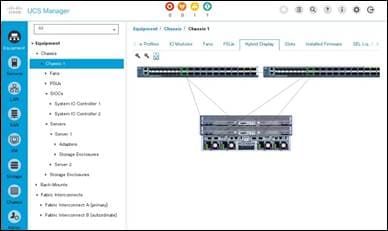
An instance of Cisco UCS Manager with all Cisco UCS components managed by it forms a Cisco UCS domain, which can include up to 160 servers. In addition to provisioning Cisco UCS resources, this infrastructure management software provides a model-based foundation for streamlining the day-to-day processes of updating, monitoring, and managing computing resources, local storage, storage connections, and network connections. By enabling better automation of processes, Cisco UCS Manager allows IT organizations to achieve greater agility and scale in their infrastructure operations while reducing complexity and risk. The manager provides flexible role and policy-based management using service profiles and templates.
Cisco UCS Manager manages Cisco UCS systems through an intuitive HTML 5 or Java user interface and a CLI. It can register with Cisco UCS Central Software in a multi-domain Cisco UCS environment, enabling centralized management of distributed systems scaling to thousands of servers. Cisco UCS Manager can be integrated with Cisco UCS Director to facilitate orchestration and to provide support for converged infrastructure and Infrastructure as a Service (IaaS).
The Cisco UCS XML API provides comprehensive access to all Cisco UCS Manager functions. The API provides Cisco UCS system visibility to higher-level systems management tools from independent software vendors (ISVs) such as VMware, Microsoft, and Splunk as well as tools from BMC, CA, HP, IBM, and others. ISVs and in-house developers can use the XML API to enhance the value of the Cisco UCS platform according to their unique requirements. Cisco UCS PowerTool for Cisco UCS Manager and the Python Software Development Kit (SDK) help automate and manage configurations within Cisco UCS Manager.
Cisco UCS 6300 Fabric Interconnects
The Cisco UCS 6300 Series Fabric Interconnects are a core part of Cisco UCS, providing both network connectivity and management capabilities for the system. The Cisco UCS 6300 Series offers line-rate, low-latency, lossless 10 and 40 Gigabit Ethernet, Fibre Channel over Ethernet (FCoE), and Fibre Channel functions.
Figure 2 Cisco UCS 6300 Fabric Interconnect

The Cisco UCS 6300 Series provides the management and communication backbone for the Cisco UCS B-Series Blade Servers, 5100 Series Blade Server Chassis, and C-Series Rack Servers managed by Cisco UCS. All servers attached to the fabric interconnects become part of a single, highly available management domain. In addition, by supporting unified fabric, the Cisco UCS 6300 Series provides both LAN and SAN connectivity for all servers within its domain.
From a networking perspective, the Cisco UCS 6300 Series uses a cut-through architecture, supporting deterministic, low-latency, line-rate 10 and 40 Gigabit Ethernet ports, switching capacity of 2.56 terabits per second (Tbps), and 320 Gbps of bandwidth per chassis, independent of packet size and enabled services. The product family supports Cisco® low-latency, lossless 10 and 40 Gigabit Ethernet unified network fabric capabilities, which increase the reliability, efficiency, and scalability of Ethernet networks. The fabric interconnect supports multiple traffic classes over a lossless Ethernet fabric from the server through the fabric interconnect. Significant TCO savings can be achieved with an FCoE optimized server design in which network interface cards (NICs), host bus adapters (HBAs), cables, and switches can be consolidated.
The Cisco UCS 6332 32-Port Fabric Interconnect is a 1-rack-unit (1RU) Gigabit Ethernet, and FCoE switch offering up to 2.56 Tbps throughput and up to 32 ports. The switch has 32 fixed 40-Gbps Ethernet and FCoE ports.
Both the Cisco UCS 6332UP 32-Port Fabric Interconnect and the Cisco UCS 6332 16-UP 40-Port Fabric Interconnect have ports that can be configured for the breakout feature that supports connectivity between 40 Gigabit Ethernet ports and 10 Gigabit Ethernet ports. This feature provides backward compatibility to existing hardware that supports 10 Gigabit Ethernet. A 40 Gigabit Ethernet port can be used as four 10 Gigabit Ethernet ports. Using a 40 Gigabit Ethernet SFP, these ports on a Cisco UCS 6300 Series Fabric Interconnect can connect to another fabric interconnect that has four 10 Gigabit Ethernet SFPs. The breakout feature can be configured on ports 1 to 12 and ports 15 to 26 on the Cisco UCS 6332UP fabric interconnect. Ports 17 to 34 on the Cisco UCS 6332 16-UP fabric interconnect support the breakout feature.
Cisco UCS 9332 Nexus Switches
The Cisco Nexus 9000 Series Switches include both modular and fixed-port switches that are designed to overcome these challenges with a flexible, agile, low-cost, application-centric infrastructure.
Figure 3 Cisco Nexus 9332 Switch

The Cisco Nexus 9300 platform consists of fixed-port switches designed for top-of-rack (ToR) and middle-of-row (MoR) deployment in data centers that support enterprise applications, service provider hosting, and cloud computing environments. They are Layer 2 and 3 nonblocking 10 and 40 Gigabit Ethernet switches with up to 2.56 terabits per second (Tbps) of internal bandwidth.
The Cisco Nexus 9332PQ Switch is a 1-rack-unit (1RU) switch that supports 2.56 Tbps of bandwidth and over 720 million packets per second (mpps) across thirty-two 40-Gbps Enhanced QSFP+ ports
All the Cisco Nexus 9300 platform switches use dual- core 2.5-GHz x86 CPUs with 64-GB solid-state disk (SSD) drives and 16 GB of memory for enhanced network performance.
With the Cisco Nexus 9000 Series, organizations can quickly and easily upgrade existing data centers to carry 40 Gigabit Ethernet to the aggregation layer or to the spine (in a leaf-and-spine configuration) through advanced and cost-effective optics that enable the use of existing 10 Gigabit Ethernet fiber (a pair of multimode fiber strands).
Cisco provides two modes of operation for the Cisco Nexus 9000 Series. Organizations can use Cisco NX-OS Software to deploy the Cisco Nexus 9000 Series in standard Cisco Nexus switch environments. Organizations also can use a hardware infrastructure that is ready to support Cisco Application Centric Infrastructure (Cisco ACI) to take full advantage of an automated, policy-based, systems management approach.
Cisco UCS S3260 M5 Storage Server
The Cisco UCS S3260 Storage Server is a modular, high-density, high availability, dual-node rack server, well suited for service providers, enterprises, and industry-specific environments. It addresses the need for dense cost effective storage for the ever-growing data needs. Designed for a new class of cloud-scale applications, it is simple to deploy and excellent for big data applications, software-defined storage environments, and other unstructured data repositories, media streaming, and content distribution.
Figure 4 Cisco UCS S3260 Storage Server
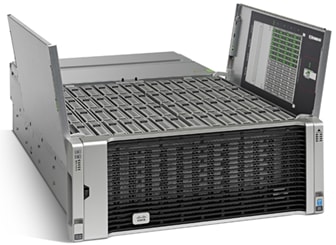
Extending the capability of the Cisco UCS C3000 portfolio, the Cisco UCS S3260 helps you achieve the highest levels of data availability. With dual-node capability that is based on the Intel Xeon scalable processors, it features up to 600 TB of local storage in a compact 4-rack-unit (4RU) form factor. All hard-disk drives can be asymmetrically split between the dual-nodes and are individually hot-swappable. The drives can be built-in in an enterprise-class Redundant Array of Independent Disks (RAID) redundancy or be in a pass-through mode.
This high-density rack server comfortably fits in a standard 32-inch depth rack, such as the Cisco R42610 Rack-Server.
The Cisco UCS S3260 is deployed as a standalone server in both bare-metal or virtualized environments. Its modular architecture reduces TCO by allowing you to upgrade individual components over time and as use cases evolve, without having to replace the entire system.
The Cisco UCS S3260 uses a modular server architecture that, using Cisco’s blade technology expertise, allows you to upgrade the computing or network nodes in the system without the need to migrate data migration from one system to another. It delivers the following:
· Dual server nodes
· Up to 44 computing cores per server node
· Up to 60 drives mixing a large form factor (LFF) with up to 28 solid-state disk (SSD) drives plus 2 SSD SATA boot drives per server node
· Up to 1.5 TB of memory per server node (3 TB Total ) with 128GB DIMMs
· Support for 12-Gbps serial-attached SCSI (SAS) drives
· A system I/O Controller either with HBA Passthrough or RAID controller, with DUAL LSI 3316 Chip
· Cisco VIC 1300 Series Embedded Chip supporting Dual-port 40Gbps
· High reliability, availability, and serviceability (RAS) features with tool-free server nodes, system I/O controller, easy-to-use latching lid, and hot-swappable and hot-pluggable components
· Dual 7mm NVMe - Capacity points: 512G, 1TB and 2TB
· 1G Host Management Port
Figure 5 Cisco UCS S3260 M5 Internals
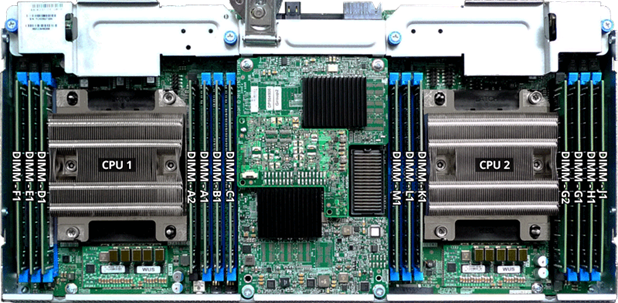
Cisco UCS C220 M5 Rack-Mount Server
The Cisco UCS C220 M5 Rack-Mount Server is among the most versatile general-purpose enterprise infrastructure and application servers in the industry. It is a high-density 2-socket rack server that delivers industry-leading performance and efficiency for a wide range of workloads, including virtualization, collaboration, and bare-metal applications. The Cisco UCS C-Series Rack-Mount Servers can be deployed as standalone servers or as part of Cisco UCS to take advantage of Cisco’s standards-based unified computing innovations that help reduce customers’ TCO and increase their business agility.
The Cisco UCS C220 M5 server extends the capabilities of the Cisco UCS portfolio in a 1-Rack-Unit (1RU) form factor. It incorporates the Intel® Xeon Scalable processors, supporting up to 20 percent more cores per socket, twice the memory capacity, 20 percent greater storage density, and five times more PCIe NVMe Solid-State Disks (SSDs) compared to the previous generation of servers. These improvements deliver significant performance and efficiency gains that will improve your application performance.
Figure 6 Cisco UCS C220M5 Rack-Mount Server

The Cisco UCS C220 M5 SFF server extends the capabilities of the Cisco Unified Computing System portfolio in a 1U form factor with the addition of the Intel Xeon Processor Scalable Family, 24 DIMM slots for 2666MHz DIMMs and capacity points up to 128GB, two 2 PCI Express (PCIe) 3.0 slots, and up to 10 SAS/SATA hard disk drives (HDDs) or solid state drives (SSDs). The Cisco UCS C220 M5 SFF server also includes one dedicated internal slot for a 12G SAS storage controller card.
The Cisco UCS C220 M5 server included one dedicated internal modular LAN on motherboard (mLOM) slot for installation of a Cisco Virtual Interface Card (VIC) or third-party network interface card (NIC), without consuming a PCI slot, in addition to 2 x 10Gbase-T Intel x550 embedded (on the motherboard) LOM ports.
The Cisco UCS C220 M5 server can be used standalone, or as part of the Cisco Unified Computing System, which unifies computing, networking, management, virtualization, and storage access into a single integrated architecture enabling end-to-end server visibility, management, and control in both bare metal and virtualized environments.
Cisco UCS Virtual Interface Card 1387
The Cisco UCS Virtual Interface Card (VIC) 1387 is a Cisco innovation. It provides a policy-based, stateless, agile server infrastructure for your data center. This dual-port Enhanced Quad Small Form-Factor Pluggable (QSFP) half-height PCI Express (PCIe) modular LAN-on-motherboard (mLOM) adapter is designed exclusively for Cisco UCS C-Series and 3260 Rack Servers. The card supports 40 Gigabit Ethernet and Fibre Channel over Ethernet (FCoE). It incorporates Cisco’s next-generation converged network adapter (CNA) technology and offers a comprehensive feature set, providing investment protection for future feature software releases. The card can present more than 256 PCIe standards-compliant interfaces to the host and these can be dynamically configured as either network interface cards (NICs) or host bus adapters (HBAs). In addition, the VIC supports Cisco Data Center Virtual Machine Fabric Extender (VM-FEX) technology. This technology extends the Cisco UCS Fabric Interconnect ports to virtual machines, simplifying server virtualization deployment.
Figure 7 Cisco UCS VIC 1387
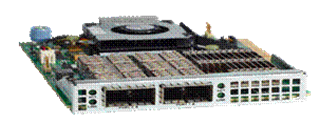
The Cisco UCS VIC 1387 provides the following features and benefits:
· Stateless and agile platform: The personality of the card is determined dynamically at boot time using the service profile associated with the server. The number, type (NIC or HBA), identity (MAC address and World Wide Name [WWN]), failover policy, bandwidth, and quality-of-service (QoS) policies of the PCIe interfaces are all determined using the service profile. The capability to define, create, and use interfaces on demand provides a stateless and agile server infrastructure.
· Network interface virtualization: Each PCIe interface created on the VIC is associated with an interface on the Cisco UCS fabric interconnect, providing complete network separation for each virtual cable between a PCIe device on the VIC and the interface on the fabric interconnect.
Red Hat Enterprise Linux 7.5
Red Hat® Enterprise Linux is a high-performing operating system that has delivered outstanding value to IT environments for more than a decade. More than 90 percent of Fortune Global 500 companies use Red Hat products and solutions including Red Hat Enterprise Linux. As the worlds most trusted IT platform, Red Hat Enterprise Linux has been deployed in mission-critical applications at global stock exchanges, financial institutions, leading telcos, and animation studios. It also powers the websites of some of the most recognizable global retail brands.
Red Hat Enterprise Linux:
· Delivers high-performance, reliability, and security
· Is certified by the leading hardware and software vendors
· Scales from workstations, to servers, to mainframes
· Provides a consistent application environment across physical, virtual, and cloud deployments
Designed to help organizations make a seamless transition to emerging datacenter models that include virtualization and cloud computing, Red Hat Enterprise Linux includes support for major hardware architectures, hypervisors, and cloud providers, making deployments across physical and different virtual environments predictable and secure. Enhanced tools and new capabilities in this release enable administrators to tailor the application environment to efficiently monitor and manage compute resources and security.
Cloudian HyperStore enables data centers to provide highly cost-effective on-premise unstructured data storage repositories. Cloudian HyperStore is built on standard hardware that spans across the enterprise as well as into public cloud environments. Cloudian HyperStore is available as a stand-alone software. It easily scales to limitless capacities and offers multi-data center storage. HyperStore also has fully automated data tiering to all major public clouds, including AWS, Azure and Google Cloud Platform. It fully supports S3 applications and has flexible security options.
Cloudian HyperStore is a scale-out object storage system designed to manage massive amounts of data. It is an SDS solution that runs on the Cisco UCS platform allowing cost savings for datacenter storage while providing extreme availability and reliability.
HyperStore deployment models include on-premises storage, distributed storage, storage-as-a-service, or even other combinations (Figure 8).
Figure 8 HyperStore Deployment Models

Cloudian Object Storage
Get everything you love about cloud storage, right in your data center. Cisco and Cloudian deliver an object storage solution that provides petabyte-scalability while keeping it simple to manage. Deploy as on-premises storage or configure a hybrid cloud and automatically tier data to the public cloud. All at 70 percent less TCO than conventional storage.
View system health, manage users and groups and automate tasks with Cloudian’s web-based UI and REST API. Manage your workload with a self-service portal that lets users administer their own storage. Powerful QoS capabilities help you ensure SLAs.
Cloudian makes it easy to get started. Begin with the cluster size that fits your needs and expand on demand. In Cloudian’s modular, shared-nothing architecture, every node is identical, allowing the solution to grow from a few nodes to a few hundred without disruption. Performance scales linearly, too.
Only Cloudian HyperStore offers a 100 percent native S3 API, proven to deliver the highest interoperability in its class. Guaranteed compatible with your S3-enabled applications, Cloudian gives you investment protection and peace of mind.
Get the benefits of both on–premises and cloud storage in a single management environment. Run your S3-enabled applications in your data center with Cloudian S3 scale-out storage. Use policies you define to automatically tier data to the public cloud. It’s simple to manage and limitlessly scalable.
Get all the benefits of using the Cisco UCS platform while managing your data through a single pane of glass.
Cloudian HyperStore Design
Cloudian HyperStore is an Amazon S3-compliant multi-tenant object storage system. The system utilizes a “non-SQL” (NoSQL) storage layer for maximum flexibility and scalability. The Cloudian HyperStore system enables any service provider or enterprise to deploy an S3-compliant multi-tenant storage cloud.
The Cloudian HyperStore system is designed specifically to meet the demands of high volume, multi-tenant data storage:
· Amazon S3 API compliance. The Cloudian HyperStore system 100% compatible with Amazon S3’s HTTP REST API. Customer’s existing HTTP S3 applications will work with the Cloudian HyperStore service, and existing S3 development tools and libraries can be used for building Cloudian HyperStore client applications.
· Secure multi-tenancy. The Cloudian HyperStore system provides the capability to have multiple users securely reside on a single, shared infrastructure. Data for each user is logically separated from other users’ data and cannot be accessed by any other user unless access permission is explicitly granted.
· Group support. An enterprise or work group can share a single Cloudian HyperStore account. Each group member can have dedicated storage space, and the group can be managed by a designated group administrator.
· Quality of Service (QoS) controls. Cloudian HyperStore system administrators can set storage quotas and usage rate limits on a per-group and per-user basis. Group administrators can set quotas and rate controls for individual members of the group.
· Access control rights. Read and write access controls are supported at per-bucket and per-object granularity. Objects can also be exposed via public URLs for regular web access, subject to configurable expiration periods.
· Reporting and billing. The Cloudian HyperStore system supports usage reporting on a system-wide, group-wide, or individual user basis. Billing of groups or users can be based on storage quotas and usage rates (such as bytes in and bytes out).
· Horizontal scalability. Running on standard off-the-shelf hardware, a Cloudian HyperStore system can scale up to thousands of nodes across multiple datacenters, supporting millions of users and hundreds of petabytes of data. New nodes can be added without service interruption.
· High availability. The Cloudian HyperStore system has a fully distributed, peer-to-peer architecture, with no single point of failure. The system is resilient to network and node failures with no data loss due to the automatic replication and recovery processes inherent to the architecture. A Cloudian HyperStore geocluster can be deployed across multiple datacenters to provide redundancy and resilience in the event of a data center scale disaster.
Cloudian HyperStore Architecture
The Cloudian HyperStore is a fully distributed architecture that provides no single point of failure, data protection options (replication or erasure coding), data recovery upon a node failure, dynamic re-balancing on node addition, multi-data center and multi-region support. Figure 9 illustrates all of the service components that comprise a Cloudian HyperStore system.
Figure 9 Cloudian HyperStore Architecture
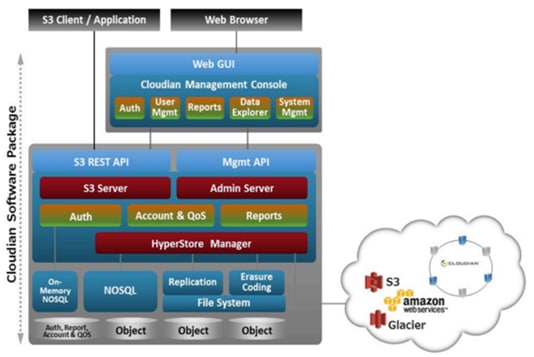
Cloudian Management Console
The Cloudian Management Console (CMC) is a web-based user interface for Cloudian HyperStore system administrators, group administrators, and end users. The functionality available through the CMC depends on the user type associated with a user’s login ID (system administrative, group administrative, or regular user).
As a Cloudian HyperStore system administrator, you can use the CMC to perform the following tasks:
· Provisioning groups and users
· Managing quality of service (QoS) controls
· Creating and managing rating plans
· Generating usage data reports
· Generating bills
· Viewing and managing users’ stored data objects
· Setting access control rights on users’ buckets and stored objects
Group administrators can perform a limited range of administrative tasks pertaining to their own group. Regular users can perform S3 operations such as uploading and downloading S3 objects. The CMC acts as a client to the Administrative Service and the S3 Service.
Figure 10 Cloudian Management Console
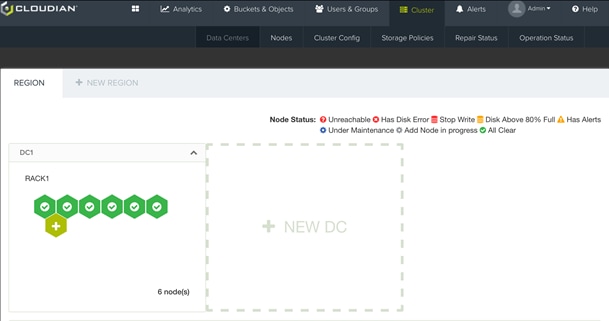
S3 Compatible
With Amazon setting the cloud storage standard making it the largest object storage environment, and Amazon S3 API becoming the de facto standard for developers writing storage applications for cloud, it is imperative every Cloud, hybrid storage solution is S3 compliant. Cloudian HyperStore, in addition to being S3 compliant, also offers the flexibility to be on-premises object storage as well as hybrid tier to Amazon and Google clouds.
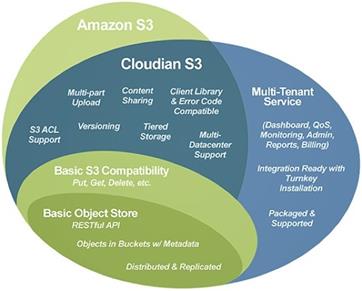
Integrated Billing, Management, and Monitoring
The HyperStore system maintains comprehensive service usage data for each group and each user in the system. This usage data, which is protected by replication, serves as the foundation for HyperStore service billing functionality. The system allows the creation of rating plans that categorize the types of service usage for single users or groups for a selected service period. The CMC has a function to display a single user’s bill report in a browser; HyperStore Admin API can be used to generate user or group billing data that can be ingested a third-party billing application. Cloudian HyperStore also allows for the special treatment of designated source IP addresses, so that the billing mechanism does not apply any data transfer charges for data coming from or going to these “whitelisted” domains.

Cloudian Features
The following are the key Cloudian features:
· Auto-Tiering
· Programmable
· Multi-Tenancy
· IAM User Support
· Broad Application Support
· Cloudian HyperStore Secret Sauce
· Distributed Peer-To-Peer Architecture
· Parallel Disk IO Data Protection
· Configurable Data Consistency
· Storage Node Heterogeneity
· Compression Your Way
· Quality of Service
Cisco and Cloudian developed a solution that meets the challenges of scale-out storage. This solution uses Cloudian HyperStore Object Storage software with Cisco UCS S-Series Storage Servers powered by Intel Xeon processors. The Cisco UCS S3260 hardware platform and Cloudian’s HyperStore Object solution combines robust availability with system management control, monitoring capabilities and reporting.
The list of features, including hybrid cloud streaming, virtual nodes, configurable erasure coding, and data compression, as well as encryption, helps set Cloudian HyperStore apart with highly efficient storage and seamless data management. This lets users store and access their data where they want it, when they want it. Built on a robust object storage platform for effortless data sharing, cloud service providers around the world use Cloudian HyperStore to deploy and manage both public and private clouds, while enterprises rely on it to maintain their private and hybrid clouds.
Infinitely Scalable on Demand
Cisco and Cloudian HyperStore offers on-demand infinite scalability, allowing you to grow your storage as needed. As your demand grows, you can seamlessly grow your storage across multiple DCs.
Security
Cisco and Cloudian HyperStore takes safeguarding customer data very seriously. Two server-side encryption methods (SSE/SSE-c, KeySecure) are implemented to ensure that data is protected at all times.
Cloudian HyperStore simplifies the data encryption process by providing transparent key management at the server or node layer. This relieves administrators from the burden of having to manage encryption keys and eliminates the risk of data loss occurring due to lost keys. Furthermore, encryption can be managed very granularly—from a large-scale to an individual object.
Data Protection
With the ISA-L Powered Erasure Coding, Cloudian HyperStore optimizes storage for all data objects, providing efficient storage redundancy with low disk space consumption.
Effortless Data Movement
Cloudian HyperStore easily manages your data, stores and retrieves your data on-demand (with unique features like object streaming, dynamic auto-tiering), and seamlessly moves data between your on-premises cloud and Amazon S3, irrespective of data size.
Deployment Architecture
The reference architecture use case provides a comprehensive, end-to-end example of designing and deploying Cloudian object storage on Cisco UCS S3260 as shown in Figure 11. This document describes the architecture and design of a Cloudian Scale-out object storage and file system solution on three Cisco UCS S3260 Storage Server Chassis'; each with two Cisco UCS S3260 M5 nodes configured as storage servers and one Cisco UCS C220 M5S rack server as Supervisor node. The whole solution is connected to a pair of Cisco UCS 6332 Fabric Interconnects and a pair of upstream network Cisco Nexus 9332PQ switches.
The configuration is comprised of the following:
· 2 x Cisco Nexus 9332PQ Switches
· 2 x Cisco UCS 6332 Fabric Interconnects
· 3 x Cisco UCS S3260 Storage Servers with 2 x Cisco UCS C3260 M5 server nodes each
· 2 x Cisco UCS C220 M5S Rack Servers (Optional for HA-Proxy)
Figure 11 Cisco UCS Hardware for Cloudian HyperStore
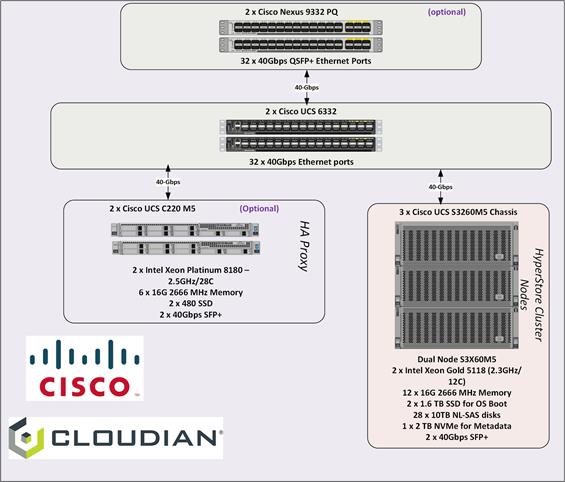
System Hardware and Software Specifications
Software Versions
Figure 12 Software Versions
| Layer |
Component |
Version or Release |
| Storage (Chassis) UCS S3260 |
Chassis Management Controller |
4.0(1c) |
| Shared Adapter |
4.0(1c) |
|
| Compute (Server Nodes) UCS S3X60 M5 |
BIOS |
S3260M5.4.0.1b |
| CIMC Controller |
4.0(1a) |
|
| Compute (Rack Server) C220 M5S |
BIOS |
C220M5.4.0.1c |
| CIMC Controller |
4.0(1a) |
|
| Network 6332 Fabric Interconnect |
UCS Manager |
4.0(1a) |
| Kernel |
5.0(3)N2(4.01a) |
|
| System |
5.0(3)N2(4.01a) |
|
| Network Nexus 9332PQ |
BIOS |
07.51 |
|
|
NXOS |
7.0(3)I4(8b) |
| Software |
Red Hat Enterprise Linux Server |
7.5 (x86_64) |
|
|
Cloudian HyperStore |
7.1.2 |
Hardware Requirements and Bill of Materials
Figure 13 Bill of Materials
| Component |
Model |
Quantity |
Comments |
|
| Cloudian Storage Nodes |
Cisco UCS S3260 M5 Chassis |
3 |
· 2 x UCS S3X60 M5 Server Nodes per Chassis (Total = 6nodes) · Per Server Node - 2 x Intel Xeon Silver 4114 (2.2GHz/10cores), 192 GB RAM - Cisco 12G RAID Controller - 2 x SSD for OS - 28 x 10TB HDDs for Data, - 1 NVMe for metadata per node. - Dual-port 40 Gbps VIC |
|
| Cloudian HA-Proxy Node (Optional) |
Cisco UCS C220 M5S Rack server |
2 |
· 2 x Intel Xeon Silver 4110 (2.1GHz/8 Cores), 96GB RAM · Cisco 12G SAS RAID Controller · 2 x 600GB SAS for OS · Dual-port 40 Gbps VIC |
|
| UCS Fabric Interconnects |
Cisco UCS 6332 Fabric Interconnects |
2 |
|
|
| Switches |
Cisco Nexus 9332PQ Switches |
2 |
|
|
Physical Topology and Configuration
The following sections describe the physical design of the solution and the configuration of each component.
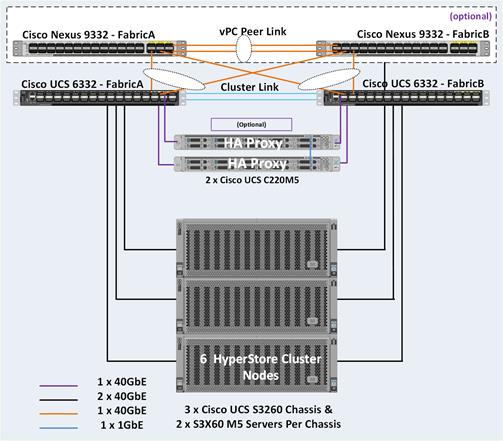
Network Topology
Figure 14 illustrates the Network Topology used in the setup.
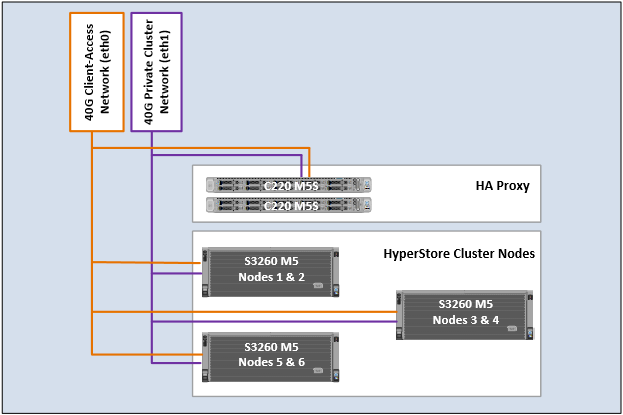
High Availability
As part of the hardware and software resiliency, the following tests will be conducted on the test bed. The results of the tests will be included in the deployment guide (to be published).
Figure 15 High Availability Tests
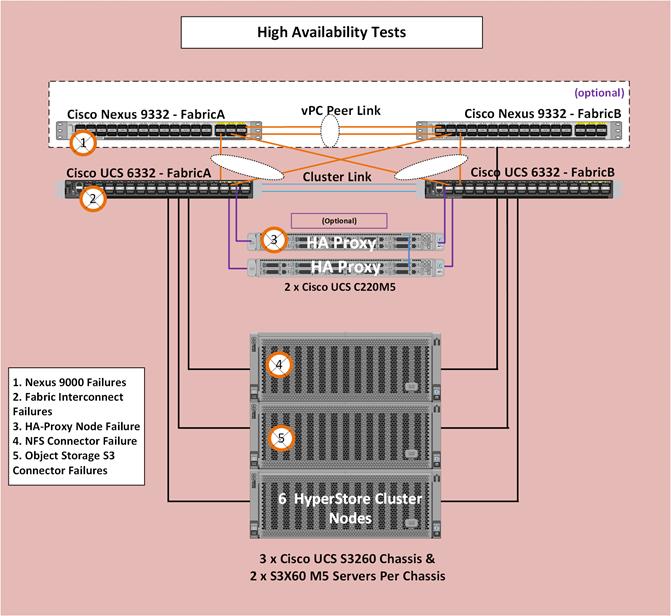
There are several use cases and target industries where you can use the Cisco UCS and Cloudian SDS solution. The use cases and industries are several, but not limited to the following (Table 1 ).
| Primary |
Backup and Archive |
| Private & Hybrid Cloud |
|
| Video/Content Distribution (VOD/Origin Server) |
|
| Media Near-line Archive |
|
| Medical Imaging |
|
| Public Cloud – Email |
|
| Public Cloud – Consumer Services |
|
| Secondary |
Video Surveillance |
| Enterprise File Sync and Share |
|
| Hadoop Datalake |
|
| Deep Learning
|
Table 2 Target Industries
| Priority |
Industry |
| Target |
Telco, Mobile Operator & Cable Operator |
| SaaS & Other Cloud Services |
|
| Financial Services |
|
| Media & Entertainment |
|
| Police & Intelligence Agencies |
|
| Hospitals and Medical Imaging Vendor |
|
| Transportation |
|
| Other Global 2000 (non XaaS, FIN,M&E,Transp,Hosp) |
The following sections describe some considerations for the design of the Infrastructure and the Cloudian HyperStore.
Requirements
The requirements for the storage have to be understood for the design. These may include the total usable space, future expansion and organic growth for the capacity of the cluster, the performance of the cluster in terms of throughput and bandwidth, the average block size of IO, single site, multi-domain or multi-site requirements, and so on.
Physical Infrastructure Considerations
Single Node versus Dual Node Cisco UCS S3260
Cisco UCS S3260 is offered with single node and dual node configurations for a full chassis in a 4RU rack space.
Cluster may be categorized as capacity-based or performance-based depending on the requirements. A dual server offers double the CPU and memory for the same set of disks. So, when performance is more important, a dual node configuration is recommended.
When performance is not that important and fewer cores per disk suffice as in backup or archives, a single node configuration is recommended. This also reduces the TCO of the solution.
Replication versus Erasure Coding
Central to Cloudian’s data protection are its storage policies. These policies are ways of protecting data so that it’s durable and highly available to users. The Cloudian HyperStore system lets you preconfigure one or more storage policies. Users, when creating a new storage bucket, can choose which preconfigured storage policy to use to protect data in that bucket. Users cannot create buckets until you have created at least one storage policy.
For each storage policy that you create, you can choose from the following two data protection methods:
Replication
With replication, a configurable number of copies of each data object are maintained in the system, and each copy is stored on a different node. For example, with 3X replication 3 copies of each object are stored, with each copy on a different node.
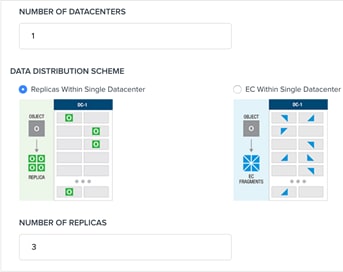
Erasure Coding
With erasure coding, each object is encoded into a configurable number (known as the “k” value) of data fragments plus a configurable number (the “m” value) of redundant parity fragments. Each fragment is stored on a different node, and the object can be decoded from any “k” number of fragments. For example, in a 4:2 erasure coding configuration (4 data fragments plus 2 parity fragments), each object is encoded into a total of 6 fragments which are stored on 6 different nodes, and the object can be decoded and read so long as any 4 of those 6 fragments are available.
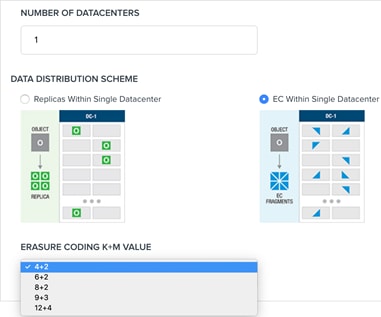
Erasure coding requires less storage overhead (the amount of storage required for data redundancy) and results in somewhat longer request latency than replication. Erasure coding is best suited to large objects over a low latency network.
Regardless of whether you use replication or erasure coding, if your Cloudian HyperStore system spans multiple datacenters, for each storage policy you can also choose how data is allocated across your datacenters — for example, you could have a storage policy that for each S3 object, store 3 replicas of the object in each of your datacenters; and a second storage policy that erasure codes objects and stores them in just one particular datacenter.
Supported Erasure Coding Configurations
Cloudian HyperStore supports EC, replicated EC, and distributed EC configurations.
· EC
This configuration requires a minimum 6 nodes across a single Data Centers (DC). This supports the minimum data and parity fragments of (4+2) where 2 is the parity. Table 3 lists the default EC configuration and the default number of nodes for a single DC.
![]() Cloudian also supports 5 nodes EC as a custom policy – EC3+2.
Cloudian also supports 5 nodes EC as a custom policy – EC3+2.
Table 3 Default EC Configuration and Default Number of Nodes
| Nodes in the DC |
EC |
| 6 |
4+2 |
| 8 |
6+2 |
| 10 |
8+2 |
| 12 |
9+3 |
| 16 |
12+4 |
· Replicated EC
This configuration requires a minimum of two Data Centers (DC). Each DC consists of 3 nodes each. This supports the minimum data and parity fragments of (2+1) where 1 is the parity. Table 4 lists the default replicated EC configuration and the default number of nodes per DC.
Table 4 Default Replicated EC Configuration and Default Number of Nodes
| Nodes Total |
DC1 |
DC2 |
EC |
| 6 |
3 |
3 |
2+1 |
| 12 |
6 |
6 |
4+2 |
| 16 |
8 |
8 |
6+2 |
| 20 |
10 |
10 |
8+2 |
| 24 |
12 |
12 |
9+3 |
Each object is encoded into equal parts and parity fragments are replicated on each node. Each DC is a mirror image. For configurations greater than 2 DC, Distributed EC configuration is recommended. This configuration mirrors the encoded data and parity fragments to the other data centers in the configuration.
The choice among these three supported EC configurations is largely a matter of how many Cloudian HyperStore nodes in the datacenter. For a replicated EC configuration, a minimum of 3 nodes per DC are required.
· Distributed EC
Cloudian’s Distributed EC solution implements the new ISA-L Erasure Codes that is vectored and fast. ISA-L is the Intel library containing functions to improve erasure coding.
The Cloudian Distributed Data Center with EC configuration requires a minimum of 3 data centers with 4 nodes each.
Data stored: DC1: 4, Dc2: 4, DC3:4, Metadata stored: Data stored: DC1: 4, DC2: 4, DC3:3
Distributed EC configuration offers the same level of protection as the replicated EC configuration with 50% less storage. The Distributed EC configuration is recommended if number of DCs involved are 3 or more.
Flash Storage
Flash Storage with SAS SSD’s or NVMe’s are used to store metadata for faster performance. The standard capacity requirement for Flash are less than 1 percent of the total data capacity. Standard design also calls for having a ratio of 1 SSD for 16 HDD. When using NVMe, one PCIe card is sufficient for all the drives in the S3260 systems.
For example, a dual node configuration has 28 disk slots for each node, so 2 SSD’s are recommended. Note that using 2 SSD’s reduces the number of slots available per node in S3260 to 28. However, using 1xNVMe as mentioned in the BOM above provides the additional 2 slots when compared with SSD’s. This slightly increases TB/RU of the servers.
JBOD versus RAID0 Disks
While Cloudian HyperStore as a SDS solution works with JBODs or with RAID0 disks, it is recommended to use JBOD for the solution. The 12G SAS RAID controller in S3260 provides up to 4G of cache that can be used for writes.
Memory Sizing
Memory sizing is based on the number of objects stored on each storage server, which is related to the average file size and the data protection scheme. Standard designs call for 384GB for the S3260 M5 single node and 192GB for the S3260 M5 dual node configurations.
Network Considerations
Cloudian Network requirements are standard Ethernet only. Please refer to the Network layout in Figure 9. While Cloudian software can work on a single network interface, it is recommended to create different virtual interfaces in Cisco UCS and segregate them. A client-access network and private-cluster network are required for the operation. Cisco UCS S3260 has two physical ports of 40G each and the VIC allows you to create out many Virtual interfaces on each physical port.
It is recommended to have a private-cluster network on one port and the client-access networks on another port. This provides 40Gb bandwidth for each of these networks. While the client-access network requirements are minimal, every storage node can take up to 40Gb of client bandwidth requirements. Also, by having the client and cluster VIC’s pinned to each fabric of the fabric interconnects, there is a minimal overhead of network traffic passing through the upstream switches for inter-node communication, if any. This unique feature of fabric interconnects and VIC’s makes the design highly flexible and scalable.
Uplinks
The uplinks from fabric interconnects to upstream switches like Nexus, carry the traffic in case of FI failures or reboots. A reboot for instance is needed during a firmware upgrade. While there is complete high availability built-in the infrastructure, the performance may drop, depending on the uplink connectors from each FI to the Nexus vPC pool. If you want ‘no’ or a ‘minimal drop’, increase the uplink connectors.
Multi-Site Deployments
Similar to Amazon S3, the Cloudian HyperStore system supports the implementation of multiple “service regions.” Setting up the Cloudian HyperStore system to use multiple service regions is optional.
The main benefits of deploying multiple service regions are:
· Each region has its own independent Cloudian HyperStore geo-cluster for S3 object storage. Consequently, deploying multiple regions is another means of scaling-out your overall Cloudian HyperStore service offering (beyond using multiple nodes and multiple datacenters to scale out a single geo-cluster). In a multi-region deployment, different S3 datasets are stored in each region. Each region has its own token space and there is no data replication across regions.
· With a multi-region deployment, your service users can choose the service region in which their storage buckets will be created. Users may choose to store their S3 objects in the region that’s geographically closest to them; or they may choose one region rather than another for reasons of regulatory compliance or corporate policy.
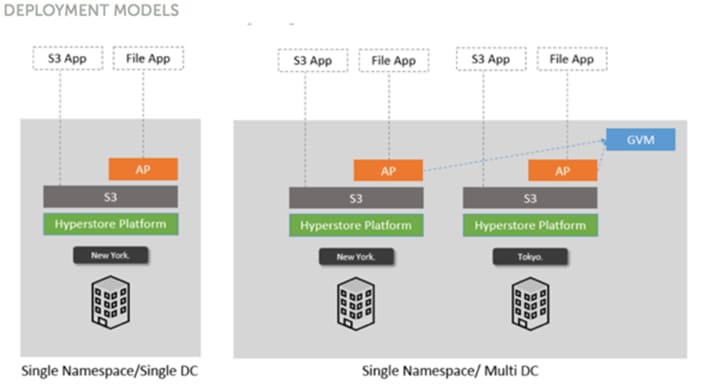
![]() Designing a multi-site is beyond the scope of this document and for simplicity, only a single site deployment test bed is setup. Please contact Cisco and Cloudian if you have multi-site requirements.
Designing a multi-site is beyond the scope of this document and for simplicity, only a single site deployment test bed is setup. Please contact Cisco and Cloudian if you have multi-site requirements.
![]() Should a customer’s workload and use case requirements not conform to the assumptions made while building these standard configurations, Cisco and Cloudian can work together to build custom hardware sizing to support the customer’s workload.
Should a customer’s workload and use case requirements not conform to the assumptions made while building these standard configurations, Cisco and Cloudian can work together to build custom hardware sizing to support the customer’s workload.
Expansion of the Cluster
Cisco UCS hardware, along with Cloudian HyperStore, offers exceptional flexibility in order to scale-out as your requirements change:
· Cisco UCS 6332 Fabric Interconnects have 32 ports each. Each server is connected to either of the FI’s. Leaving the uplinks and any other clients directly connected to the Fabrics, 24-28 server nodes can be connected to FI pairs. If more servers are required, you should plan for a multi-domain system.
· Cisco UCS offers KVM management both in-band and out-of-band. In case out-of-band management is planned, you may have to reserve as many free IP’s as needed for the servers. Planning while designing the cluster makes expansion very straightforward.
· Cisco UCS provides IP pool management, MAC pool management along with policies that can be defined once for the cluster. Any future expansion for adding nodes and so on, is just a matter of expanding the above pools.
· Cisco UCS is a template and policy based infrastructure management tool. All the identity of the servers is stored through Service Profiles that are cloned from templates. When a template is created, a new service profile for the additional server, can be created and applied on the newly added hardware. Cisco UCS makes Infrastructure readiness, extremely simple, for any newly added storage nodes. Rack the nodes, connect the cables, and then clone and apply the service profile.
· When the nodes are ready, you may have to follow the node addition procedure per the Cloudian documentation.
The simplified management of the infrastructure with Cisco UCS and well-tested node addition from Cloudian makes the expansion of the cluster very simple.
The test bed was deployed with 6 x Cisco UCS S3260 storage nodes. While a few functional tests were completed, more in-depth tests will follow. The findings of these tests and the resulting best practices will be documented in the deployment guide, which will be published at a later date.
Figure 16 Snapshot from Test Bed
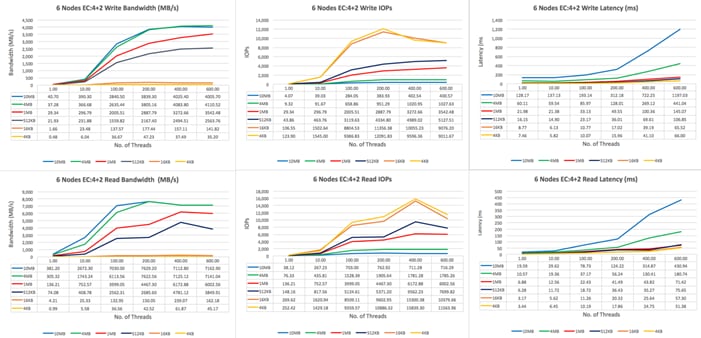
Cisco UCS Infrastructure for Cloudian Software Defined Storage is an integrated solution to deploy Cloudian HyperStore and combines the value of Intel Xeon architecture, Cisco data center hardware and software, along with Red Hat Linux. This solution increases the speed of deployment and reduces the risk of scaling from proof-of-concept to full-enterprise production, and is validated and supported by Cisco and Cloudian.
Cisco UCS hardware with Cisco UCS Manager Software brings an integrated, scalable, multi-chassis platform in which all resources participate in a unified management domain. Creating and cloning service profiles from its templates and maintaining the hardware from a single pane of glass not only provides rapid provisioning of hardware but also makes management and firmware upgrades simpler.
Cloudian HyperStore software makes it easy to build fully featured, Amazon S3-compliant cloud storage, on-premise. Cloudian HyperStore software ensures unlimited scale, multi-data center storage, fully automated data tiering, and support for all S3 applications—all behind your firewall.
Cloudian HyperStore software deployed on Cisco UCS S-Series servers, combines robust availability with system management control, monitoring capabilities and reporting. A host of features, including hybrid cloud streaming, virtual nodes, configurable erasure coding, and data compression and encryption sets Cloudian apart with highly efficient storage and seamless data management that lets you store and access your data where you want it, when you want it. Built on a robust object storage platform for effortless data sharing, cloud service providers around the world use Cloudian HyperStore to deploy and manage both public and private clouds, while enterprises rely on it to maintain their private and hybrid clouds.
This Cisco Validated Design is a partnership of Cisco Systems, Inc. and Cloudian. Combining these technologies, expertise and experience in the field, we are able to provide an enterprise-ready hardware and software solution.
Muhammad Ashfaq, Cisco Systems, Inc.
Muhammad Ashfaq is a Technical Marketing Engineer in Cisco UCS and Data Center Solutions Group. He has over 10 years of experience in IT Infrastructure, Server Virtualization, and Cloud Computing. His current role includes building Cloud Computing, Software defined Storage, Automation and Management, Converged and Hyper-Converged Solutions on Cisco UCS platforms. Muhammad also holds Cisco Internetwork Expert Data Center Certification (CCIE-DC).
Acknowledgements
For their support and contribution to the design, validation, and creation of this Cisco Validated Design, the authors would like to thank:
· Chris O’ Brien, Cisco System, Inc.
· Ramakrishna Nishtala, Cisco Systems, Inc.

 Feedback
Feedback